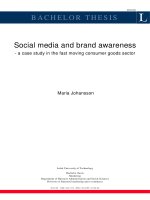heineken case study business analysis
Bạn đang xem bản rút gọn của tài liệu. Xem và tải ngay bản đầy đủ của tài liệu tại đây (929.04 KB, 31 trang )
S iê u thị điệ n máy Việ t Lo ng www.vie tlo ng plaza.c o m.vn
HEINEKEN CAS E S TUDY
Overview
1.
2.
3.
4.
5.
6.
7.
Corporate Objective and goals
beer industry overview
Problems
5 forces
SWOT anlaysis
Value chain analysis
Solutions
S iê u thị điệ n máy Việ t Lo ng www.vie tlo ng plaza.c o m.vn
Heineken Overview
one of the world’s leading brands >130 years.
Number 2 imported beer in U.S.
Number 1 in Europe
global network of distributors and 115
breweries in more than 65 countries
Premier brands – Heineken, Amstel Light
S iê u thị điệ n máy Việ t Lo ng www.vie tlo ng plaza.c o m.vn
Organization goals and
objectives
Aims for sustainable growth as a broad market
leader and segment leadership
Expand and optimize product portfolio
embraced innovation as a key component of
their strategy in the areas of production,
marketing, communication and packaging.
Goal is to grow the business in a sustainable and
consistent manner, while constantly improving
profitability
Priority to reach goal
1. to accelerate sustainable top-line growth.
2. to accelerate efficiency and cost reduction.
3. to speed up implementation: we commit to
faster decision making and execution.
4. to focus on those markets where we believe
we can win.
S iê u thị điệ n máy Việ t Lo ng www.vie tlo ng plaza.c o m.vn
Problem
1.
Losing Import beer market share
Problem: The maturing competitive
Beer Industry
Emergence
Maturity
Decline
Demand (units/year)
Introduction
Time
Beer Industry Overview
Beer Industry Overview
37% of U.S. adults are beer drinkers
Beer is the most widely purchased alcohol
beverage
Beer industry is projected to grow steadily
S iê u thị điệ n máy Việ t Lo ng www.vie tlo ng plaza.c o m.vn
Competition
Basically it’s “eat or be eaten”
Every company is just trying to strengthen
their global position any way possible
Biggest rivals include InBev and Grupo
Modelo
Mergers and Acquisitions
South African PLC combined with Miller
InterBrew and AmBev merged in 2004, and
now acquired Anheuser-Busch
Coors acquired Molson
Anheuser-Busch in partnerships with Grupo
Modelo and Tsingtao
S iê u thị điệ n máy Việ t Lo ng www.vie tlo ng plaza.c o m.vn
Business Strategy of the
Industry
Grow externally to strengthen the position of
the company in developed markets as well as
maximizing potential for profit in high-growth
markets
Basically do whatever is necessary to get your
company represented around the world
Heineken was the pioneer of this strategy,
becoming the first brewer to cut deals to
distribute worldwide
Industry Outlook
Bigger brewers acquiring smaller brewers all
over the world
“The era of global brands is coming.” – Alan
Clark, SABMiller
Market for premium beer will expand 84% by
2012
Value Chain Analysis
(Primary Activities)
Value Chain Analysis
(Secondary Activities)
Porter’s 5 Forces of competition
Porter’s 5 Forces of competition
Thre ats o f s ubs titute s
very little technical composition
of beers
Growing appreciation for wine
Thre ats o f ne w e ntry
$250 million needed to build 4
million barrel brewery
Entry is risky since not many
alternative uses for breweries
No new entrant in beer industry
has cracked the top 3 sellers
since WWII.
Porter’s Five Forces of competition
(cont’d)
Barg aining Po we r o f Buye rs
No loyalty to any particular brand
Demand “beer” is inelastic: E=-0.7
Demand “Budweiser” is elastic: E=-5.0
Barg aining Po we r o f S upplie rs
fewer brewers and Larger
plants
170 Horizontal mergers
between 1950-1983
Rising cost of key commodities
like grain, glass and aluminum
Many Buying supplier of inputs
(wheat field)
Porter’s Five Forces of competition
(cont’d)
Rivalry be twe e n e s tablis he d c o mpe tito rs
1947: Top 5 firms -19% of market in the U.S.
2001: Top 5 generate 87% of the market in the U.S.
Highly competitive industry, many brewers leave the industry
losing $
Lost of advertising for product differentiation
SWOT Analysis
S tre ng th
Brands in over 13 markets
Very Differentiated
Global brand/pioneer of international strategy
Has made many acquisitions with national breweries
Bottle Recognition and different dispensing instruments
Green Bottle
Mini keg
SWOT Analysis
We akne s s
Conservative/”Play it safe” culture
Struggle to obtain large breweries
Not drank by younger beer drinkers
Although consumption age has dropped from 40 to 30
Price when compared to U.S. domestic beers
$10 per six pack—Heineken
$7 per six pack--Domestic
SWOT Analysis
Thre ats
Increase in Drunk-driving laws
Competitors increasing market share
U.S. Industry
Mergers and acquisitions of other breweries
Other Breweries are becoming much larger than Heineken’s
Brewery
“In danger of becoming a tired, reliable, but unexciting brand”
J ohn A. Quelch
SWOT Analysis
Oppo rtunity
Low calorie beer
Society is pushing for a “healthy” beer
Russia/Asia
Population increasing dramatically
Have greater market share
Hispanic consumer’s are growing rapidly
U.S. Industry









